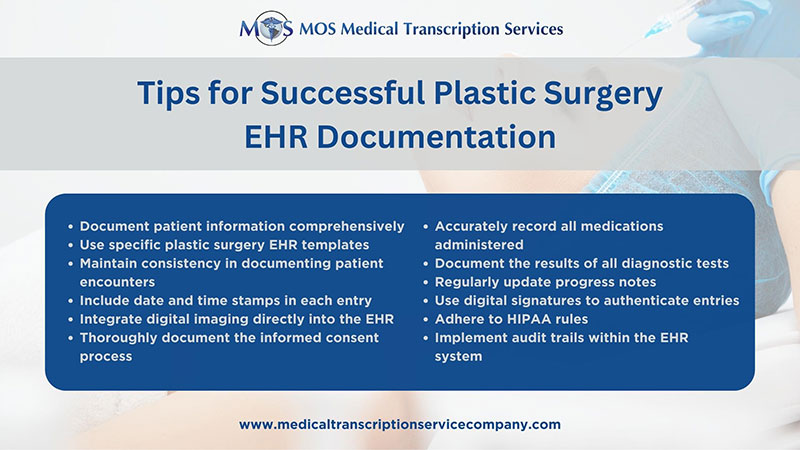
Compliance with best practices for Electronic Health Record (EHR) documentation is crucial for plastic surgeons. It not only improves accessibility to patient information but also enhances patient engagement and retention. A professional medical transcription company, focusing on plastic surgery transcription, provides cost-effective, EHR-integrated documentation solutions. These services assist surgeons in effortlessly managing, retrieving, and securely storing patient records.
EHR features customized for plastic surgery practices encompass effortless image uploading and annotation, inventory management, skincare needs documentation, and purchase history tracking. Additionally, seamless integration with practice management software streamlines medical billing. These systems should also prioritize patient engagement and provide access to relevant patient education resources.

Best Practices for EHR Documentation in Plastic Surgery
Here are some best practices for plastic surgery EHR documentation:
- Clear and detailed notes: Document patient information comprehensively, including medical history, allergies, current medications, and any pre-existing conditions. Clear and detailed notes are essential for providing appropriate care and ensuring patient safety.
- Procedure-specific templates: Utilize EHR templates specifically designed for plastic surgery procedures. These templates should include fields for the procedure type, pre-operative assessments, surgical techniques, and post-operative care plans.
- Consistency: Maintain consistency in documenting patient encounters. Use standardized terminology and abbreviations to avoid confusion and misinterpretation.
- Date and time stamps: Ensure that each entry in the EHR includes a date and time stamp. This helps establish a timeline of care and facilitates auditing and tracking.
- Digital imaging: Integrate digital imaging directly into the EHR for before-and-after photos. This allows for easy comparison and tracking of surgical outcomes.
- Informed consent: Document the informed consent process thoroughly. Include details about discussions with the patient regarding the procedure, potential risks, benefits, and alternatives.
- Medication records: Accurately record all medications administered during surgery and for post-operative pain management. Include dosages, routes of administration, and times of administration.
- Diagnostic tests: Document the results of any pre-operative or post-operative diagnostic tests, such as bloodwork or imaging studies.
- Progress notes: Regularly update progress notes to reflect changes in the patient’s condition, post-operative recovery, and follow-up visits. Document wound healing, signs of infection, and any complications.
- Digital signatures: Use digital signatures to authenticate entries in the EHR. Ensure that only authorized personnel have access to make changes or add entries.
- HIPAA compliance: Adhere to Health Insurance Portability and Accountability Act (HIPAA) guidelines to protect patient privacy and confidentiality. Limit access to patient records to authorized individuals only.
- Training and education: Provide ongoing training and education to staff members on proper EHR documentation practices. This ensures that all team members are proficient in using the system effectively and accurately.
- Audit trails: Implement audit trails within the EHR system to track any changes or access to patient records. This enhances accountability and security.
- Backup and data recovery: Regularly back up EHR data and have a robust data recovery plan in place to prevent data loss in case of technical issues or disasters.
- Compliance with regulations: Stay up-to-date with regulations and compliance standards specific to plastic surgery, such as those from the American Society of Plastic Surgeons (ASPS) and state medical boards.
By following these best practices for EHR documentation, plastic surgeons can ensure the quality of care, patient safety, and compliance with industry standards and regulations.
Plastic surgery has its distinct terminology, which could be complex. Proficient medical transcriptionists possess in-depth knowledge of these nuances, including procedure types, surgical incisions, suture methods, techniques, patient positioning, and lab tests. They excel in producing precise, error-free reports spanning a broad range of procedures, from chemical peels and dermabrasion to breast augmentation, liposuction, abdominoplasty, blepharoplasty, rhinoplasty, facelifts, reconstructive surgeries, and more. By providing accurate plastic surgery transcription, medical transcriptionists play a pivotal role in enabling surgeons to deliver high-quality care.


